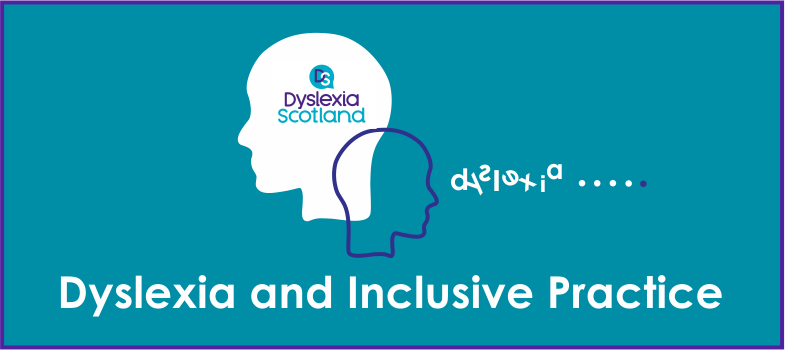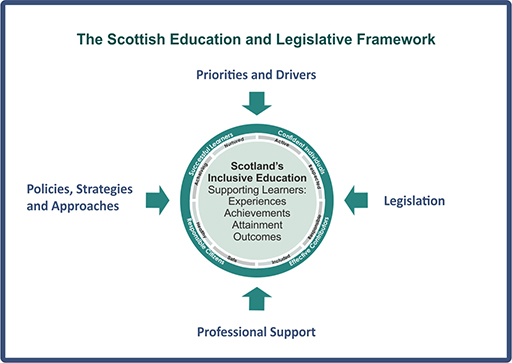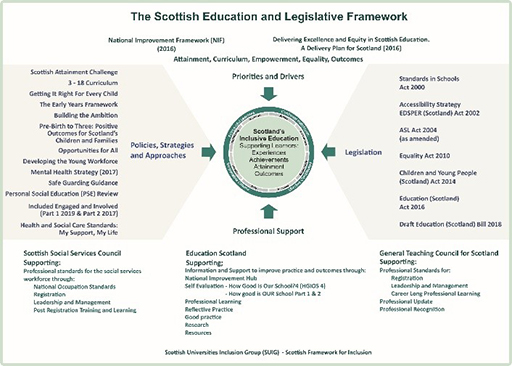1.1. The Scottish context for dyslexia and inclusive practice
As we consider the educational provision for children and young people with dyslexia in Scotland, it is important to acknowledge and consider the national agenda, legislative and guidance context that local authorities, educational practitioners and health care professionals work within. Scotland’s education system is rights based, inclusive, and designed to make sure that every child and young person is entitled to support to enable them to gain as much as possible from the opportunities that their education can provide.
Scotland’s ‘child-centred needs led’ education system has been designed to ensure that the provision of support for a child or young person is not dependent upon them receiving a formal label or identification of need such as autism, dyslexia or a physical disability.
The Scottish vision for inclusive education, which applies to all settings and for all children and young people, is set out below:
'Inclusive education in Scotland starts from the belief that education is a human right and the foundation for a more just society. An inclusive approach which recognises diversity and holds the ambition that all children and young people are enabled to achieve to their fullest potential is the cornerstone to achieve equity and excellence in education for all of our children and young people.'
Children’s rights and entitlements are fundamental to Scotland’s approaches to inclusive education. It is supported by the legislative framework and key policy drivers including the Getting it right for every child approach (often referred to as GIRFEC), Curriculum for Excellence and the Framework for Professional Standards for teachers. These are underpinned by a set of values aligned to social justice and commitment to inclusive education. This means that inclusive education should be at the heart of all areas of educational planning.
Figure 2 provides you with an overview of the Scottish education and equality context.
Legislation which places duties on schools and local authorities to support and provide inclusive education for learners in Scotland can be linked directly to the United Nations Convention on the Rights of the Child (UNCRC).
Our legislation ensures rights and entitlements for children and young people to education, support and wellbeing. There is a range of legislation and educational policies that places duties and expectations on schools and local authorities to ensure that they:
- Promote a child centred approach to encourage every child to reach their ‘fullest potential’
- Deliver an inclusive education
- Support learners to achieve to the best of their ability
- Do not discriminate against those with protected characteristics
- Provide assessments when requested.
The legislation and policy also provide the framework for support and planning. This is called the Staged Level of Intervention and you will explore this in Section 4 Support, assessment and planning.
Figure 3 below provides a more detailed overview of the national legislation and policy that underpins the Scottish educational context of inclusion and equality. It is not intended as an exhaustive list of all Scottish policies which refer to inclusion but gives a broad overview of some of the key legislation and policy documents.
Select here [Tip: hold Ctrl and click a link to open it in a new tab. (Hide tip)] to download a copy of this image.
Recent policies and legislation
Select here to download the summary of the Scottish Educational Legislative and Policy Framework which provides an overview of the most recent legislation and policies.
The Making Sense Review
The 2014 Education Scotland report ‘Making Sense: Education for Children and Young People with Dyslexia in Scotland’ was the outcome of an independent review of education for children and young people who have dyslexia, carried out on behalf of the Scottish Government.
The report identified 5 interconnecting recommendations for local authorities and schools, all of which combine to improve the outcomes for learners with dyslexia:
- Access to up-to-date practical advice and guidance on dyslexia
- Access to wide a range of high-quality career-long professional opportunities at school, local and national level
- Initial Teacher Education (ITE) and postgraduate awards should give high priority to developing knowledge and skills in relation to dyslexia
- Action to improve the quality of educational outcomes for children and young people with dyslexia
- Availability and use of reliable information on children and young people’s needs, development and achievement should be improved.
1. Scottish Education




